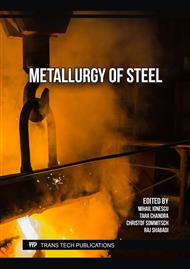p.1
p.7
p.13
p.19
p.29
p.35
p.41
p.47
Characterization and Separation of Damage Mechanisms of Extruded Case-Hardening Steel AISI 5115 under Cyclic Axial-Torsional Loading
Abstract:
Due to the emerging relevance of topics such as climate change or scarcity of resources, the requirements for energy efficiency, emissions and resource conservation are increasing. In this context, components manufactured by metal forming offer a high potential for lightweight construction, cost effectiveness and resource efficiency. The defects resulting from forming processes e.g. in form of micropores and their growth are currently not taken into account. A commercial design is usually based on mechanical material properties and additional safety factors. The knowledge of the ductile forming-induced damage in the component design enables an improved design. In this study, the influence of different forming process parameters during full forward rod extrusion on the structural damage and the fatigue properties were investigated for the case-hardened steel AISI 5115 (16MnCrS5, 1.7131). The intention was to compare the fatigue properties of different damage states under cyclic axial and axial-torsional loading including the identification and separation of underlying damage mechanisms. A significant effect of superimposed cyclic torsional loading on cyclic axial properties and mechanisms was found, which was associated with a decrease of 38 % in the lifetime. Axial-torsional fatigue tests were conducted at various test temperatures to determine the effect of forming-induced damage and test temperature on the fatigue strength. In addition, differences in microstructure as a result of forming-induced and fatigue-induced damages were validated by using scanning electron microscopy.
Info:
Periodical:
Pages:
13-18
Citation:
Online since:
November 2023
Authors:
Price:
Сopyright:
© 2023 Trans Tech Publications Ltd. All Rights Reserved
Share:
Citation:



